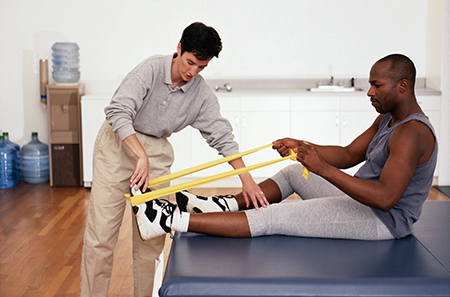 Speeding up the recovery time for patients following ankle or tibial plateau fracture is the goal of a new study in the Department of Orthopaedic Surgery at the University of Alabama at Birmingham.
Speeding up the recovery time for patients following ankle or tibial plateau fracture is the goal of a new study in the Department of Orthopaedic Surgery at the University of Alabama at Birmingham.
The multi-center study, funded by the United States Department of Defense, will evaluate whether early weight-bearing following ankle or lower leg fractures will allow a patient to recover faster and return to work or duty more quickly.
The study will call for appropriate patients to begin weight-bearing two weeks after a surgical repair rather than the current standard of care: six to eight weeks following surgery for an ankle fracture and 10 to 12 weeks for a tibial plateau fracture.
“The idea is to help patients return to their normal lives more quickly and with less disruption,” said Clay Spitler, M.D., associate professor of orthopaedic surgery. “Advances in surgical technique and improvements in physical therapy suggest that the old standard of care can and should be updated.”
Spitler says under the current standard of care, a tibial plateau or ankle fracture can keep an individual sidelined from activities such as walking, running or any active use of the lower extremities for as many as three months.
“We think we can cut that in half and get people back to their normal routines much more quickly,” Spitler said.
The study is sponsored by METRC, the Major Extremity Trauma and Rehabilitation Consortium, funded by the DOD. METRC is a collaboration of more than 50 civilian trauma centers and four military treatment facilities throughout the United States and Canada. The consortium is dedicated to establishing treatment guidelines for the optimal care of injured service members and ultimately improving the clinical, functional and quality of life outcomes of both military personnel and civilians who sustain high-energy trauma to the extremities.
 The study will enroll 600 participants in the United States and Canada at 20 sites. UAB has been named a primary study site, and has a goal to enroll between 50 and 100 participants.
The study will enroll 600 participants in the United States and Canada at 20 sites. UAB has been named a primary study site, and has a goal to enroll between 50 and 100 participants.
The participants will be randomized into two groups. Each will get range of motion exercises, but the study group will add early weight-bearing exercises and begin to walk sooner than the control group.
Those in the study group will receive instructions for in-home exercises and will meet with physical therapists. They will have a choice between self-directed exercises or continued sessions with a physical therapist.
“We will prescribe a daily exercise program, which will maintain and increase ankle range of motion,” Spitler said. “Participants will also do strengthening exercises and begin to walk two weeks post-surgery. Walking allows patients to use muscles that would otherwise suffer from dis-use.”
There are exclusions to the study, primarily with elderly populations or those with poor bone health.
“Our goal is to help our patients recover and return to normal daily activities as soon as possible,” Spitler said. “We’re excited to be a primary site for this study that has the potential to lead to major changes in rehabilitation of lower-extremity injuries.”